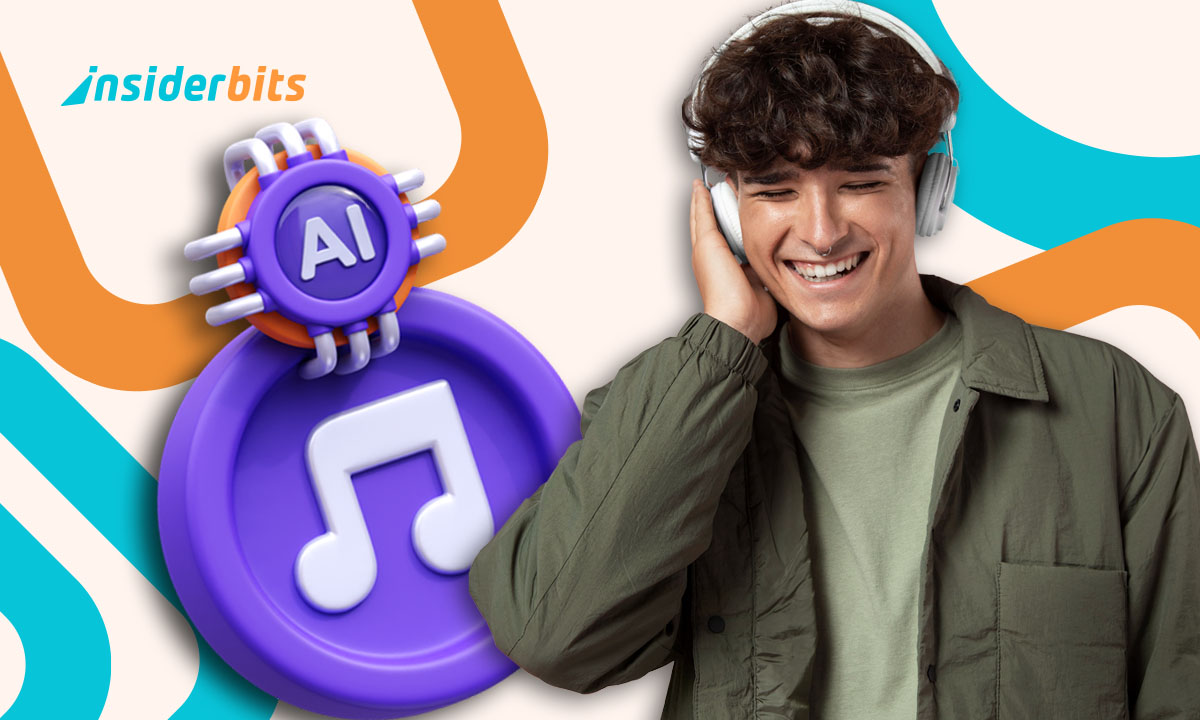Making music no longer requires a studio or expensive gear. With AI songwriters, anyone can generate full songs just by selecting a genre, mood, and tempo in seconds. These tools assist content creators, musicians, and hobbyists. Some spark ideas, others build polished tracks from scratch. And the best part? You get room to customize everything.
This is a guide by Insiderbits built to demystify the tools behind this trend. Curious about usage rights, best platforms, or creative control? Keep reading and learn all about it.
Verwandt: Essential AI Tools for Copywriters, Programmers, Designers & Architects
How AI generates melodies, beats, and full compositions
Music creation has become more dynamic thanks to artificial intelligence. Today, software can turn creative input into structured sound, layering instruments, rhythm, and mood into tracks.
The process begins with a few choices: tempo, emotion, musical style. Based on that, the system builds melodies and beats designed to match your intent, energy, and tone.
What happens next is automation. AI tools balance randomness and structure to avoid generic results while keeping compositions coherent. That’s where the magic of AI songwriters begins.
From genre to mood: defining the creative parameters
Most AI tools ask the user to select key elements like genre, speed, mood, and instrumentation. These choices help the system shape how the music should feel and evolve.
Choosing a chill acoustic vibe, for example, tells the algorithm to favor soft instruments. Want tension? Darker tones, minor scales, and stronger percussion come into play.
Algorithms that understand rhythm, harmony, and structure
Behind the scenes, AI maps thousands of musical samples and compositions. It learns how rhythm drives flow, how harmony builds emotion, and how structure gives meaning to sound.
It doesn’t simply copy patterns—it identifies relationships between notes, measures, and styles. This knowledge is what allows it to compose tracks that feel intentional, not just assembled.
Different models, different results: a look under the hood
Each AI platform uses a distinct model trained on different datasets. Some rely on classical theory, others on modern genres. That’s why outputs vary so much between tools.
Some tools focus on fast output with minimal input, while others offer layered customization. That flexibility has helped AI songwriters gain traction among professionals and casual creators.

Best AI songwriters to create your own music instantly
Creating music no longer demands years of training or complex software. With just a few clicks, anyone can build full-length songs tailored to personal taste, mood, or specific project needs.
These tools adapt to input in real time. Some favor simplicity and speed, while others offer deeper control for more personalized, polished results.
Soundraw: adaptive soundscapes with a professional edge
Soundraw makes it easy to create custom tracks in minutes. Pick a mood, genre, and length, then let the system generate original instrumentals built for quick editing.
The platform uses AI songwriters to generate music you can adjust. That means control without needing to compose manually. Tracks can be fine-tuned for intros, background loops, or ads.
Soundraw is often used for content creation, presentations, and video soundtracks. It supports commercial use through subscription, making it a go-to for creators needing music that adapts.
Soundraw’s best features
- Customizable tracks in seconds: choose length, mood, and genre, then modify structure and intensity to suit your creative project perfectly;
- Clear licensing for creators: all tracks are approved for monetized content, making Soundraw a practical choice for professional and personal media projects;
- User-friendly editing interface: easily adjust sections, transitions, and energy levels with a clean design built for creators without technical backgrounds.
Boomy: make a track in seconds, no skills required
Boomy lets anyone create and release songs in just minutes. You can choose a style, press create, and edit the results with tools powered by innovative AI songwriters.
It’s designed for simplicity, but still gives control. Users can adjust vocals, structure, and effects, then publish directly to streaming platforms without leaving the app or dealing with licenses.
The platform appeals to hobbyists and casual creators looking for fast results. It’s also used by artists needing quick inspiration or background tracks for content, podcasts, and short videos.
Boomy’s best features
- Instant music creation: generate a complete song in seconds by selecting a style and letting the system handle the rest automatically;
- Direct publishing options: release tracks to streaming platforms with one click, making distribution fast and accessible for independent creators;
- Editable vocals and effects: customize vocal layers, audio filters, and transitions to match your tone, even without prior experience in music production.
SongStarter: creative boosts for musicians on the go
SongStarter helps users spark musical ideas fast. Type a few words or paste lyrics, and the tool generates beat suggestions powered by adaptive AI songwriters behind the scenes.
Each beat comes with three variations, offering creative flexibility without needing technical skills. Users can preview, tweak tempo, and use results as a launchpad for new concepts.
Created by BandLab, the platform connects easily with full DAWs for continued editing. It’s ideal for musicians needing a creative push or a fast way to test lyrics.
SongStarter’s best features
- Lyric-to-beat generator: type a phrase or idea and receive musical suggestions that match the vibe and tone instantly;
- Three variations per track: each result includes different styles and energy levels, giving users more flexibility to match the tone they need;
- Easy DAW integration: connect directly with BandLab or export files to other platforms for full control over your music production process.
Verwandt: 5 AI Tools You Should Know Before Everyone Else Does
Royalty-free vs. commercial licensing with AI tracks
Not all AI-generated songs are free to use as you wish. Usage terms depend on the platform, the plan, and how you intend to publish content.
Some services offer royalty-free tracks with clear limits, while others charge for commercial use or streaming. It’s a key concern for those using AI songwriters professionally or publicly.
Free to use? It depends on the platform
Some platforms allow free use for personal projects, but restrict commercial publishing. It’s important to check what’s covered before using the music in public or monetized content.
Soundraw, for example, includes commercial rights with a paid plan, while Boomy allows releases but keeps a share of the royalties. Terms like these vary greatly between services.
Always read the licensing details carefully. A song generated for fun can quickly become a legal headache if used incorrectly in ads, branded content, or published media channels.
Subscription, licensing, or limited rights: reading the fine print
Licensing often depends on the type of account. Free users may only get limited rights, while paid plans include broader use across digital and commercial environments.
Some platforms that feature AI songwriters also offer one-time licenses instead of subscriptions. This helps creators who only need occasional tracks without committing to monthly fees.
Understanding the terms protects your work from takedowns or copyright claims. Knowing your rights is essential when music is generated by automated systems.
From YouTube to corporate videos: who are these tools really for?
Creators using music for YouTube intros, podcasts, or livestreams need hassle-free rights. Platforms offering pre-cleared use make life easier and protect channels from strikes.
Small businesses and marketing teams also benefit from accessible licensing. Instead of hiring composers, they can generate polished tracks aligned with their brand or campaign goals.
The use of AI songwriters in professional settings continues to grow, providing fast solutions where custom music once required larger budgets and longer production times.
The future of creativity: AI + human collaboration
Artists and machines are making music together in new ways. Software now responds to input, learns patterns, and contributes ideas, shaping tracks through interaction instead of templates.
These systems allow users to create with tools that suggest melodies and respond to creative prompts. Music becomes more fluid when guided by instinct and supported by automation.
AI songwriters play a role in this shift by offering composition support and sparking unexpected directions. They help creators build tracks that reflect personal taste without writing every note.
Can a machine be an artist? The authorship dilemma
When music is generated from a set of prompts, it challenges traditional ideas of authorship. Is the creator the person, the algorithm, or the company behind the software?
Legal frameworks have not fully caught up with these new tools. In many regions, copyright requires human input, raising questions about rights, ownership, and monetization.
AI songwriters complicate the discussion further by learning from music libraries. Their output may sound original, but the process lacks intent or emotional authorship as we usually define it.
Inspiration, not replacement: how musicians use AI creatively
AI tools are becoming part of the creative toolkit. Musicians use them to explore rhythm patterns, unlock new harmonies, or develop instrumental lines from scratch with minimal friction.
These tools help when ideas stall or time is short. Many artists keep control over arrangement and sound, treating AI-generated pieces as sketches rather than polished final products.
By supporting the early stages of production, AI gives room for experimentation without pressure. The results are still guided by personal taste, musical identity, and creative effort.
Where we’re heading: hybrid workflows and next-gen tools
Music creation is moving toward blended environments where traditional production tools meet intelligent systems. These setups make real-time suggestions and support faster testing.
Some platforms use AI songwriters that adapt to creative habits, suggesting musical choices based on style history or recent edits. The result feels tailored even when machine-assisted.
As these tools evolve, workflows become less linear. Artists may jump from idea to ready content more fluidly, supported by systems designed to respond rather than control.
Verwandt: How to Use AI to Summarize Academic Papers
The future of songwriting is already composing hits
AI music tools are expanding what’s possible in sound creation. With just a few prompts, anyone can shape beats, moods, and melodies into songs that feel polished and personal.
This guide from Insiderbits explored how AI songwriters operate, what they bring to creative projects, and how technology supports new approaches without removing musical identity.
Looking for more content that mixes creativity with tech? Browse Insiderbits and discover practical tools, thoughtful articles, and ideas that make digital creation more exciting.





